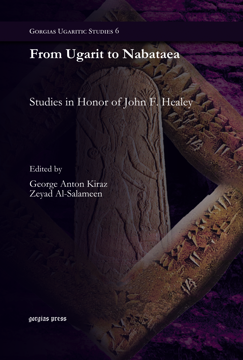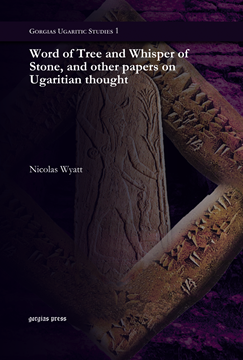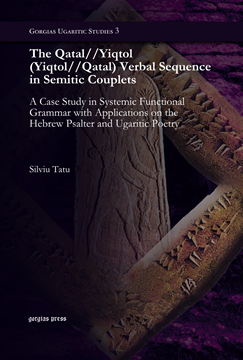Gorgias Ugaritic Studies
This series contains monographs and edited collections on the world of ancient Syria and its surrounding cultures, its language, society, religious beliefs, and ancient literary works fundamental to the contextualization of the Hebrew Bible and its interpretation.
A Reassessment of Asherah (paperback)
With Further Considerations of the Goddess
Series: Gorgias Ugaritic Studies 2
ISBN: 978-1-4632-4983-0
Asherah is one of the most popular goddesses known from the ancient world. In this second edition of the author’s 1993 monograph on the goddess, further articles and bibliography have been added to bring this expanding field of study more up-to-date. To date, this monograph contains the only full-length treatment of the Ugaritic material on Asherah in addition to a comprehensive examination of the textual sources from the Hebrew Bible, ancient Mesopotamia, Epigraphic South Arabian and Hittite sources, as well as the intriguing Hebrew inscriptions that perhaps mention the goddess.
$69.00 (USD) $41.40 (USD)
The Ethics of Violence in the Story of Aqhat
By Chloe Sun
Series: Gorgias Ugaritic Studies 8
ISBN: 978-1-59333-975-3
An examination of the ethics of violence in the Ugaritic story of Aqhat using the conventions of characterization and the conflicting points of view. The points of view of the divine characters El, Baal, Anat, Yatpan, are contrasted with the points of view of the human characters, Aqhat, Dan'il and Pughat, in order to bring out the multi-dimensional aspect of Anat's violence.
$141.00 (USD) $84.60 (USD)
Lesser Deities in the Ugaritic Texts and the Hebrew Bible
A Comparative Study of Their Nature and Roles
Series: Gorgias Ugaritic Studies 7
ISBN: 978-1-59333-820-6
A comparative work on the nature and various roles of the lesser deities, the so-called angels, in the Ugaritic texts and the Hebrew Bible. Sang Youl Cho insists on the necessity for a comparative study between the two religious literatures from Ugarit and ancient Israel. The present study is interested in their membership in the heavenly council, their kinship among the deities, and their roles such as messengers, warriors, mediators, or servants, which have numerous similarities in the Ugaritic texts and the Old Testament.
$177.00 (USD) $106.20 (USD)
From Ugarit to Nabataea
Studies in Honor of John F. Healey
Edited by George Anton Kiraz & Zeyad Al-Salameen
Series: Gorgias Ugaritic Studies 6
ISBN: 978-1-4632-0180-7
From Ugarit to Nabataea is a collection of articles on the texts and cultures of various Near and Middle Eastern societies such as Ugarit, Ancient North Arabia, Nabatea, Palmyra, Edessa, the monasteries of Mesopotamia, and modern day Syriac-speaking communities. They include discussion of the religious beliefs, iconography, epigraphy, architecture and language of these societies – fields to which John F. Healey has contributed in his long, distinguished and varied career.
$160.00 (USD) $96.00 (USD)
Theophany and Chaoskampf
The Interpretation of Theophanic Imagery in the Baal Epic, Isaiah, and the Twelve
Series: Gorgias Ugaritic Studies 5
ISBN: 978-1-61719-160-2
The imagery of thunder and lightning, fire and earthquake which attends YHWH's theophany in Old Testament poetic texts has most often been interpreted as a series of metaphors in biblical scholarship. This work applies insights from recent work in metaphor theory and myth theory to argue that this traditional interpretation of poetic theophanic imagery is mistaken, and that these texts make better exegetical sense when understood against the background of the ANE myth of the defeat of chaos.
$163.00 (USD) $97.80 (USD)
Fillets of Fatling and Goblets of Gold
The Use of Meal Events in the Ritual Imagery in the Ugaritic Mythological and Epic Texts
By Dan Belnap
Series: Gorgias Ugaritic Studies 4
ISBN: 978-1-59333-084-2
This study focuses on the imagery of meals and feasting in the Baal Myth and Kirta and Aqhat epics. Utilizing contemporary approaches to ritual, these meal events reveal the manner in which ritual behavior described and defined the different social relationships with the Ugaritic pantheon and the interactions between the divine and mortal realms. This study demonstrates the role successful ritual behavior played in the organization and presentation of characters within the narratives, as well as the role of unsuccessful or failed rituals associated with the meal event, which resulted in social chaos and confusion.
$179.00 (USD) $107.40 (USD)
Word of Tree and Whisper of Stone, and other papers on Ugaritian thought
Series: Gorgias Ugaritic Studies 1
ISBN: 978-1-59333-716-2
This volume is a collection of selected essays on specific themes in Ugaritic literature. Included are eight unique contributions to understanding the religious life and thought of Ugarit, including detailed studies and essays covering broader issues for grasping the worldview of ancient Syria.
$178.00 (USD) $106.80 (USD)
The Qatal//Yiqtol (Yiqtol//Qatal) Verbal Sequence in Semitic Couplets
A Case Study in Systemic Functional Grammar with Applications on the Hebrew Psalter and Ugaritic Poetry
By Silviu Tatu
Series: Gorgias Ugaritic Studies 3
ISBN: 978-1-59333-958-6
The book investigates the qatal//yiqtol (yiqtol//qatal) verbal sequence, previously known as ‘tense shifting’, as found in couplets of the Hebrew Psalter, attempting an innovatory explanation by means of M.A.K. Halliday’s Systemic Theory. This study argues that qatal and yiqtol verbal forms, when part of the qatal//yiqtol verbal sequence in Psalms' poetic couplets, can be used primarily for aesthetic reasons, with no individual reference to time or aspect. Arguably, the Systemic Functional Grammar analysis of lexicogrammar can provide a comprehensive interpretation of form and function and an integrated approach to phonetics, morphology and syntax.
$226.00 (USD) $135.60 (USD)
A Reassessment of Asherah
With Further Considerations of the Goddess
Series: Gorgias Ugaritic Studies 2
ISBN: 978-1-59333-717-9
Asherah is one of the most popular goddesses known from the ancient world. In this second edition of the author’s 1993 monograph on the goddess, further articles and bibliography have been added to bring this expanding field of study more up-to-date. To date, this monograph contains the only full-length treatment of the Ugaritic material on Asherah in addition to a comprehensive examination of the textual sources from the Hebrew Bible, ancient Mesopotamia, Epigraphic South Arabian and Hittite sources, as well as the intriguing Hebrew inscriptions that perhaps mention the goddess.
$179.00 (USD) $107.40 (USD)









